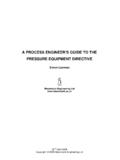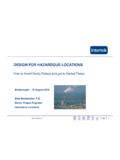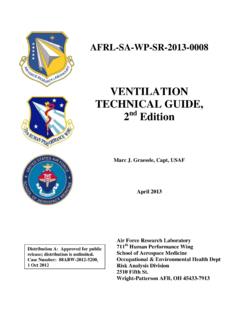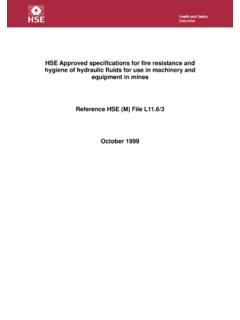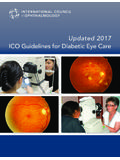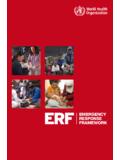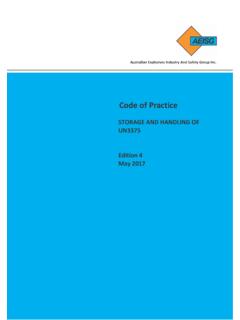Transcription of A PROCESS ENGINEER’S GUIDE TO THE - Blackmonk
1 22nd April 2009 Copyright 2009 Blackmonk Engineering Ltd A PROCESS engineer S GUIDE TO THE PRESSURE EQUIPMENT DIRECTIVE Simon Learman Blackmonk Engineering Ltd Blackmonk Engineering Ltd 2 Contents Contents .. 2 Preface .. 3 Introduction .. 4 PROCESS Engineers & the PED .. 4 Determining the Hazard Category .. 5 Equipment Excluded From the PED .. 5 Types of Pressure Equipment .. 7 Fluid State .. 8 Fluid Group .. 9 Classification Charts .. 10 Determine the Maximum Allowable Pressure & Defining Dimension .. 16 Determine the PED Hazard Category .. 16 Conformity assessment .. 16 Examples.
2 18 24 PED Classification Flowchart .. 25 Blackmonk Engineering Ltd 3 Preface Thank you for reading this GUIDE . I hope that it will give you a clear introduction to the Pressure Equipment Directive and be of help to you in your work. I would appreciate any feedback you have good or bad. Let me know what you find useful, what could be improved and what else you would find helpful in future. Email: Best regards, Simon Learman Blackmonk Engineering Ltd Blackmonk Engineering Ltd 4 Introduction The Pressure Equipment Directive (PED) is a European Union Directive applicable to the design, manufacture and conformity assessment of pressure equipment and assemblies of pressure equipment with a maximum allowable pressure greater than barg.
3 The basic purpose of the PED is to ensure that pressure equipment used in the European Economic Area1 (EEA) is safe. Additionally, because the requirements of the Directive are common to all states within the EEA, all equipment complying with the PED may be sold and used anywhere within the EEA. This promotes the free movement of goods within the EEA. Within the UK, the Pressure Equipment Regulations 1999 (PER) and subsequent amendments implement the European Union Pressure Equipment Directive. Failure to comply with the Pressure Equipment Regulations is illegal and can result in prosecution and penalties on conviction of a fine, imprisonment or both.
4 PROCESS Engineers & the PED Design of pressure equipment and pressure systems in the PROCESS industries inevitably involves PROCESS engineers. Given that all relevant equipment, plant and systems in the EEA must comply with the PED, it is essential that PROCESS engineers have at least a basic understanding of the requirements of the Directive. Essentially, the PED requires the level of hazard of pressure equipment to be assessed and classified into 1 of 5 categories. The 5 categories are: SEP (Sound engineering practice) Category I Category II Category III Category IV The higher the level of hazard, the more extensive the level of quality assurance required during the design, manufacture and testing of the equipment.
5 It is generally the PROCESS engineer s responsibility to determine the hazard category of each particular equipment item and system. 1 The European Economic Area consists of the member states of the European Union plus Iceland, Norway and Liechtenstein. Increasing level of hazard Blackmonk Engineering Ltd 5 Determining the Hazard Category In order to classify pressure equipment correctly, the PROCESS engineer must follow the methodology stated in the PED. This methodology is summarised in the flowchart at the end of this GUIDE . Once it is determined that the equipment is covered by the PED, the classification has 6 steps: 1.
6 Determine the type of pressure equipment being considered 2. Determine the state of the fluid in the equipment 3. Determine the hazard group of the fluid in the equipment 4. Select the appropriate hazard category chart 5. Determine the maximum allowable pressure and the defining dimension of the equipment 6. Determine the PED hazard category Equipment Excluded From the PED Some equipment is excluded from the Pressure Equipment Directive (and therefore also the Pressure Equipment Regulations). Excluded equipment includes: Pressure equipment and assemblies placed on the market before 29 November 1999 Pressure equipment or assemblies placed on the market on or before 29 May 2002 if they comply with the safety provisions in force in the UK on 29 November 1999 and do not bear a CE marking (unless required by another Community Directive or any indication of compliance with the PED) Pressure equipment and assemblies as listed below: 1.
7 Pipelines 2. Water supply, distribution and discharge networks 3. Simple pressure vessels (as per Directive 87/404/EEC) 4. Aerosol dispensers 5. Equipment intended for vehicles Blackmonk Engineering Ltd 6 6. Equipment classified no higher than PED Category I for the following: a. Machinery (Directive 98/37/EC) b. Lifts (Directive 95/16/EC) c. Electrical equipment for certain voltages (Directive 73/23/EEC) d. Medical devices (Directive 93/42/EEC) e. Burning gaseous fuels (Directive 90/396/EEC) f. Equipment and protective systems intended for use in potentially explosive atmospheres (Directive 94/9/EC) 7.
8 Military equipment 8. Nuclear equipment, failure of which may cause an emission of radioactivity 9. Well control equipment including wellhead (Christmas tree), blowout preventers (BOP), piping manifolds and upstream equipment 10. Casings and machinery where pressure is not a significant design factor which may include: a. Engines (including turbines and internal combustion engines) b. Steam engines, gas/steam turbines, turbogenerators, compressors, pumps and actuating devices 11. Blast furnaces and associated equipment 12. Enclosures for high voltage electrical equipment 13. Pressurized pipes for the containment of transmission systems such as electrical power and telecommunications cables 14.
9 Ships, rockets, aircraft and mobile off-shore units 15. Pressure equipment consisting of a flexible casing tyres, balls, air cushions, inflatable craft 16. Exhaust and inlet silencers 17. Bottles or cans for carbonated drinks 18. Vessels designed for transport and distribution of drinks with a maximum allowable pressure x volume of not more than 500 and a maximum allowable pressure of not more than 7 barg. 19. Equipment covered by the following: a. ADR (European Agreement concerning the International Carriage of Dangerous Goods by Road) b. RID (Regulations concerning the International Carriage of Dangerous Goods by Rail) c.
10 IMDG (International Maritime Dangerous Goods Code) d. ICAO (International Civil Aviation Organization) 20. Radiators and pipes in warm water heating systems Blackmonk Engineering Ltd 7 21. Vessels designed to contain liquids with a gas pressure above the liquid of not more than barg The detailed list of excluded equipment can be found in Article 1 Section 3 of the Pressure Equipment Directive: Types of Pressure Equipment The PED defines 6 types of pressure equipment: 1. Vessel 2. Steam generator 3. Piping 4. Safety accessories 5. Pressure accessories 6. Assemblies The first step in determining the PED category of a particular piece of equipment is to select the appropriate equipment type from the list.
